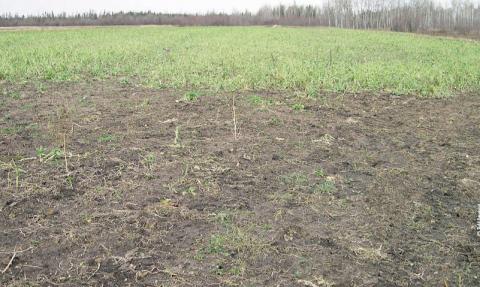Tracy Schmidt | Originally published in GameKeepers: Farming for Wildlife Magazine. To subscribe, click here.
The square-jawed old nanny stepped cautiously out into the lush alfalfa field. She was the last in a line of five antlerless deer that had filtered their way from a red pine plantation bedding area. She was by far the biggest, too. They nipped at the fresh, green growth as they picked their way across the field’s northeast corner. They were heading for a creek bottom that led to a clover field. I was tucked just off the field’s corner, hunkered between a huge fallen white oak and a tangle of brush. It was the perfect ambush — a natural ground blind with a 15-yard shooting lane to the field’s edge.
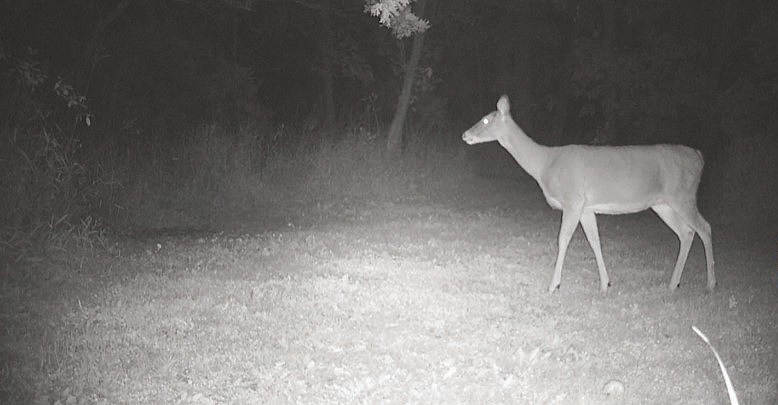
The deer walked single-file past my hideout. Twin fawns, a buck and a doe, were first, followed by a yearling doe and then a 2-1/2-year-old doe. The big doe was last, and she seemingly hung 10 to 15 yards behind the other deer. She was old and smart. Of course, I wanted to put my tag on her. Tense moments turned to minutes. All the other deer cleared the field as the big doe finally stepped into my shooting lane. I came to full draw, put the arrow’s fletching to my pursed lips, floated my top pin on her lungs and touched the release.
Thwack! The 100-grain Muzzy hit the mark, burying the shaft deep into her chest. She mule-kicked, sprinted about 75 yards and collapsed.
Great Memories
That was my first successful whitetail bowhunt, and it happened more than fifteen years ago. Despite having killed numerous does in the years that have passed, it remains one of the biggest we have ever hung from our garage scale. She weighed 137 pounds field dressed.
That’s the thing about does and doe hunting; they provide every bit the excitement and venison as a racked buck, especially for hunters who are still earning their stripes. But even as the shine wanes (a little bit), it’s still gratifying to fill the freezer with doe meat. Less than 10 years ago, the deer management mantra across the country was clear: Kill does, and lots of them. Our whitetail herds were bulging at the seams, and something had to be done. Are those good, ol’ days gone? Hardly. We still have plenty of regions where doe hunting is needed and very necessary to keep the herd within acceptable carrying capacities.
If you’re one of the lucky ones to live in an area with ample doe tags, you probably ask yourself a few questions each hunting season:
1. How many does should I harvest this year?
2. Which age classes should I target?
3. When should I harvest them?
When I first started hunting I thought all of this was over-the-top stuff. I mean, really, what difference does it make? My husband, who is a “certified deer geek,” educated me on the whole process which I now find rather fascinating. Admittedly, our doe harvest strategies have changed over the years. Here’s a primer on how we approach the two main phases of hunting season — before the rut and after the rut. Here are some insights on how we approach both of them.
Before the Rut
If there is an easy time to harvest mature does, it’s during the early bowhunting season. The deer haven’t been harassed for eight or nine months, and you’re usually dealing with completely unpressured animals. You can routinely put a fat doe or two in the freezer during the early bow season if you’re prudent about how you hunt them.
As was the case with the big doe described in the intro to this article, mature nannies are typically in matriarch mode during the first week or two of the early season. They will be traveling with a fawn (or more likely two) from this season along with last year’s fawns and, sometimes, their female offspring from the year before. That’s one constant with white-tailed does. They live and travel in maternally related groups of females, and their home ranges overlap.
Think of it as connected rings across the landscape. In most parts of the country, a mature doe’s home range is only a couple hundred acres at best, and the biggest, healthiest does occupy the best of the best of that home range.
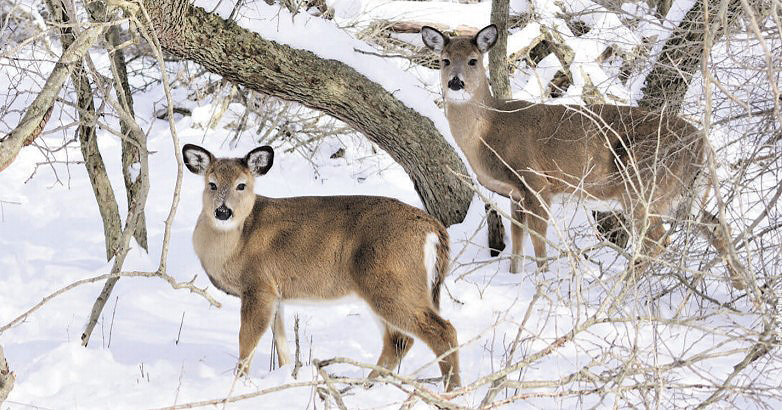
With that in mind, my husband has drilled it into my head that it is not only prudent but also very acceptable—and a good hunting practice—to target 1-1/2-year-old does (18 months old) when we are doe hunting before the rut. There are several reasons for this approach. First, yearling does are reaching nomad status. By their second autumn, these deer will be striking off (not far, mind you) from their natal range in search of their new core home range. They’re easily patterned during these months, and taking one or two off a property that’s either at or above prescribed deer density goals makes perfect management sense
Highly seasoned hunters will also target doe fawns during the early season. It’s controversial, yes, but they are much easier to identify during this time of the season. It should also be noted that targeting doe fawns, although a good management practice, should really be limited to those cases where a property is overrun with whitetails. However, if you are still one of those lucky hunters who lives and hunts in areas with high deer densities, the best tactic is to kill does early and often and make sure a preponderance of those are of the younger age groups.
Younger deer still have not achieved maximum skeletal capacity. Hence, they eat more. The more they eat, the more pressure they put on your food plots and native tree and shrub species. It doesn’t take long for a high density herd to wreak havoc on your otherwise well-intended habitat plans. The downside to shooting does before the rut is the obvious consequences that come into play when bucks start seeking breeding opportunities; however, this is only a small downside since bucks will still search out the remaining does. Three does or ten does, the bucks will still show up.
After the Rut
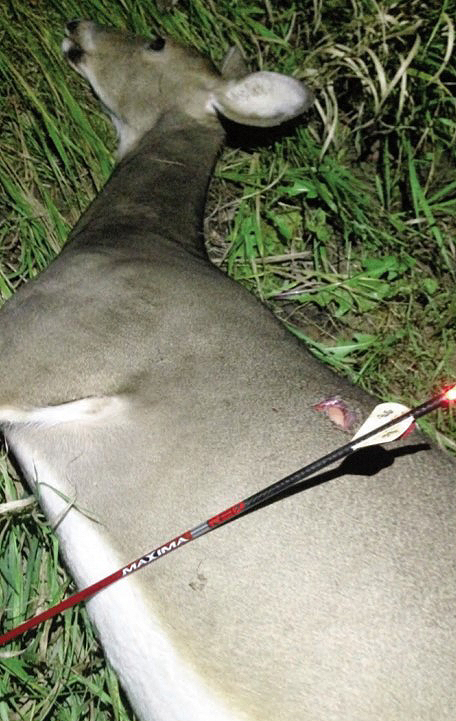
don't invoke complicated rules on beginners. In these cases, any
doe is a good doe to put on the meat pole. Besides, well-regulated
harvests include deer of all classes.
There are a few advantages to waiting until after the rut to conduct the bulk of your doe hunting efforts. First, the rut’s over, which means you’ve had some pretty fantastic hunting and, hopefully, filled your buck tag. All of the prime-age does have been bred, and you can now pick and choose which ones make it till next year. It’s about as close as you are going to get to selecting genetic sires for your free-ranging whitetails. The post rut also provides the opportunity for you to census your local herd a bit more carefully via trail cameras and field counts. You can assess how many deer are still calling your land home and then, fairly accurately, decide how many does should be taken out.
Let’s say you determine that five does can safely be harvested from your 300-acre property. This allows you to then determine an age distribution between fawns, yearlings and full-grown adults. The men who taught me how to hunt didn’t always subscribe to this theory, but they now insist that no more than 20 percent of the annual doe harvest be comprised of fully mature does. It’s very difficult to age does on the hoof, but with some practice you can easily determine which ones are at least 2-1/2 years old or younger.
So, the obvious advantage is you get to enjoy a frenetic rut. But that’s also part of the downside to waiting this long to harvest your does! As any seasoned deer hunter will attest, few mature bucks are as wise and wary as a fully mature doe. The reason for this is that mature does are always on their “A” game. Unlike a buck, which suffers from A.D.D. for at least a few weeks each year, a mature doe will pick you out of a tree stand or ground blind almost 10 times out of 10 after the pressure of hunting season is in full swing. And therein lies the rub for hunting your does during the postrut. If you wait too long, you run a sizable risk that you won’t achieve your harvest quotas by the time the season ends. This is a very real concern for hunters who have numbers problems on their properties.
The next-biggest concern is the presence of buck fawns (button bucks) in the antlerless segment. It depends on where you hunt, but where I live (central Wisconsin); buck fawns can easily attain field-dressed body weights of 80 to 90 pounds by Thanksgiving. Add in a thick winter coat, and they often appear as prime, plump does, especially when they’re traveling with a doe-fawn sister. Mistakes happen, and buck fawns get shot. It’s not the end of the world, but it is a downside to late-season doe hunting.
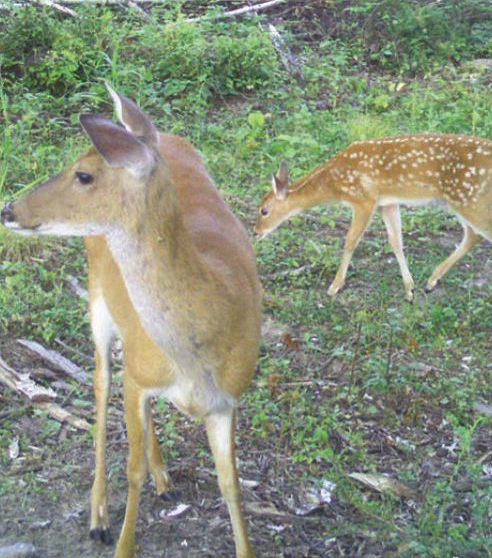
should not concern a hunter to target does that have fawns in tow when
hunting season arrives. Fawns are fully functioning ruminants by the time
September rolls around, so there is no worry in harvesting the adult doe.
It’s important to remember that more than 20 percent of nearly every state’s antlerless harvest is comprised of buck fawns. As my hunting group often talks about, it’s a necessary evil to making sure we take enough deer off the landscape. When in doubt, don’t shoot. Even better carry a good pair of binoculars with you. If you say, “I better take a second look,” you will spare some buck fawns from the harvest.
Conclusion
Everyone loves antlers for the wall, and nearly all of our deer hunting dreams involve old Mossy horns appearing out of nowhere and ambling into our sights. That’s all well and good, but the real fun in pursuing deer, in my opinion, are those everyday hunts when we can get excited about taking any deer home for the freezer. However, these aren’t just any deer; they are usually those big, old nannies with thick hindquarters and square heads. They’re the “meat makers” of the herd that keep my grill and slow cooker in business (so to speak) throughout the year. They are the renewable protein resource that trumps anything else that runs, crawls or flies.
Tracy L. Schmidt is a master food preservation specialist and avid deer hunter from Wisconsin.

















